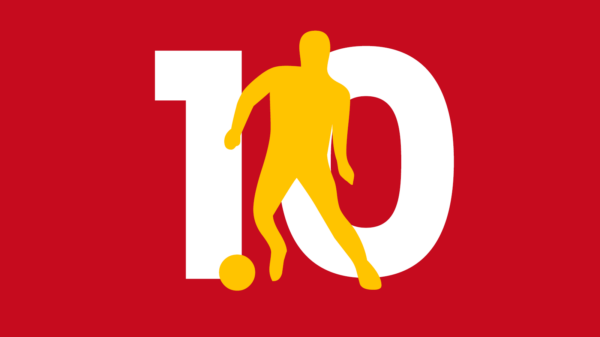
This four part series focuses on the Atletico Madrid tactics deployed this season as they’re on course to stopping the duopoly in the Spanish La Liga while also being a fresh new wave in the latter stages of the UEFA Champions League.
The first part was a short piece on their basic formation, without going into too much detail. The second piece digs right into the tactics and analyses their build-up play in terms of attacking organisation.This will be followed by the third part which is a continuation of the attacking analysis and details how Simeone’s men set-up in the attacking third in attacking phases. The final part analyses the factor which Atletico Madrid have received much praise for- their defensive set-up.
OFFENSIVE ORGANISATION
On a basic outlook, upon receiving the ball, the players have been instructed to rush the ball to the midfield-third as soon as possible. Also, as the play progresses, the ball is gradually pushed out wide. The ball is then put into the offensive third with a narrowing approach, and now the ball progression converges towards the striker.
Occasional long balls to the False Target-Man are utilized to rush the ball into the progressive third. This rather physical approach serves as a great alternative for opposition that play with quick players and high-intensity pressing tactics to squeeze out the ball from short passing sides.
The team predominantly relies on short passes for ball progression. Long balls are preferred over through balls. This complements the players in the squad who are rather strong physically. Long balls are the reason why the team can function at a quick pace even without players with immense pace.
The instructions asserting the players to rush the ball out of the defensive third and push it out wide does not favor retention of possession. Atletico Madrid have averaged only about 47% possession up until now this season, but even with the quick rush-passing play, they still boast a 79% pass success percentage.
BUILD-UP PLAY: Defensive Third
The only intent of play in the defensive third is to move the ball into midfield as soon as possible. In fact, only 25% of Atletico Madrid’s total touches this season have been attributed to the defensive zone.
Steady Approach: Short-Passing
The short-passing approach begins when the ball falls to the feet of the Anchor. The Anchor usually drops deep to pick the ball up in the defensive third and then begins to push the ball out wide –preferably to a full-back.

The Anchor (Gabi) drops deep into his half to collect the ball from the center-back (Miranda). The other midfielders now progress into the opposition half and the play now quickens.
The wide playmaker on the side of possession then drops a little deeper, along with the false-targent man and the box-to-box midfielder, causing partial overload. The full-back and playmaker on the opposite flank make steady progression into the midfield third.
Direct Approach: Long Ball
The direct approach constitutes a long ball played forward, looking for the false Target-Man occupying the berth behind the striker. More than often, the long ball is played by the ball-playing Centre-Back

The centre-back (Miranda) plays a long-ball in search of the false target-man (Garcia), who then knocks it down for the play-maker (Turan). Garcia drifts right to receive the pass. Turan moves in line with Garcia for the knockdown. Costa stays on the lookout for a looping header or a long ball from Turan.
The wide playmaker on the right is a roaming-playmaker. The False Target Man first drops slightly towards the right to receive the long pass. He then pursues on to knock the ball down for a midfielder, or directly loops it into the offensive third. Since passes arriving from the looping header can be anticipated much easily than those from the feet, runs are easier to time, reducing the risk of disappointing offside calls during a progressive build-up, and increasing the chances of breaking the opposition offside trap without having to take defenders on and risk losing the ball.
Alternatively, the pass may be played directly out wide in search of preferably a full-back or a wide playmaker, especially while undertaking a counter-attacking approach.(However, these passes are, more than often, made by the defensive midfielders when given time and space – especially during home games.)
Comment
- The Center-Backs average almost 7 long-range pass attempts each per game, and have an average of 4 successful long passes per game. In his 8 appearances, Toby Alderweireld has made 75 long-pass attempts, making 42 successful long-passes in the process (5.3 accurate/game). Miranda and Godin have made 322 long-ball attempts between them, 192 of those being accurate.
- The two players that have been circulated in the False Target-Man role behind the striker (i.e. Raul Garcia and Diego Costa) have faced more aerial challenges than any other player in their squad – including the defenders. Raul Garcia has won the most aerial duels in the team (76 won) and averages about 3 successful aerial challenges per game. The only player who has won more aerial challenges than Costa (42 won) is the centre-back Godin (64 won).
BUILD-UP PLAY: Midfield
As the ball progresses into midfield through the short-passing approach, the team now adjusts structure to move the ball out wide. The defensive midfielders now move to the side of possession, creating a partial intentional overload.
Short passing and Triangles
The overload now favors the formation of multiple small triangles. The ball is now moved up the pitch through these triangles with quick short exchanges. The primary triangles are usually directed out wide to shift the ball wider as the play progresses.

Comment
- Almost 75% of touches made by the team in the opposition half were made out wide (40% left; 35% right), indicating the shift of play and overload of players out wide before chance creation.
- The team makes approximately 360 short passes per game, which is 80% of the total passes they make in a game. About 55 long passes are made per game. Only a mere 1% of the total constitutes through-balls (2 through-balls/ game).
Plan B: Long passes
Upon failure to progress along the overloaded flank, the play may either progress towards the other flank through the Anchor, or under intense pressure from the opposition, long passes are played by the midfielders to the opposite flank, initially in search of the false-target man.
Comment
- The midfielders have a great passing record, with all of them having a passing success rate of about 80% (Gabi 79.5%; Tiago 81%; Mario Suarez 84%).
- Each midfielder makes an average of 5.5 long pass attempts per game. Gabi makes 4.4 accurate long passes per game from midfield. Tiago averages 3.7 accurate long passes per game, followed by Mario Suarez (at 2.8). Gabi has attempted 56 more long-balls than Tiago and Suarez put together, establishing him as the most frequent source of long balls from midfield, and also explaining his comparatively low pass success rate.
This piece was written by Sauharda Karki. Follow him on twitter @sodaboix
- Premier League: The Growing Trend Of Counter-Attacking Goals - June 11, 2020
- Analysis | Three Things We Learned: NorthEast United 0-1 Bengaluru FC - December 9, 2017
- Three Things We Learned: NorthEast United 0-0 Jamshedpur - November 19, 2017
























































